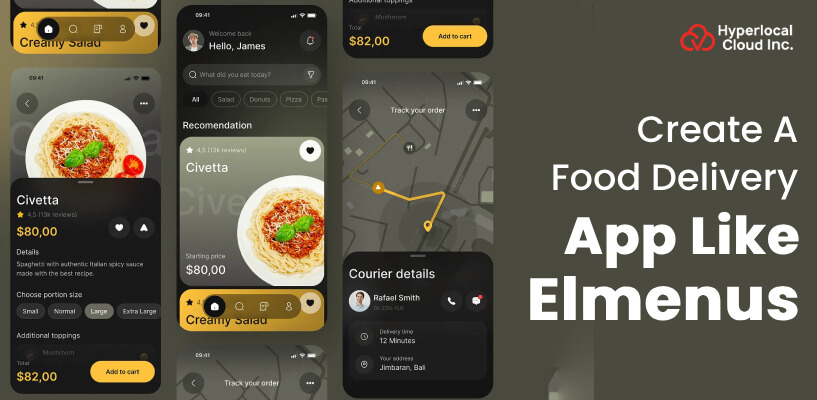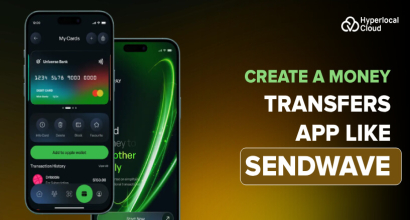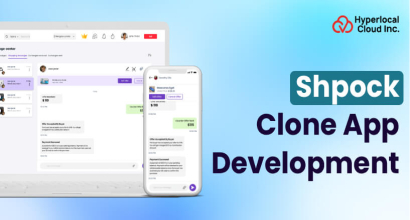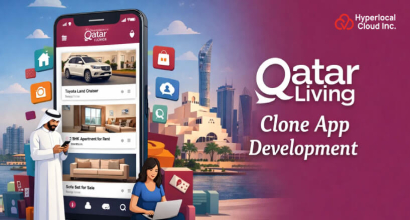In recent years, the food distribution industry has experienced rapid growth worldwide. With the growing demand for online food, more people are choosing mobile applications to enjoy their favourite food from the comfort of their home. In many successful food distribution applications in the market, Elmenus has emerged as one of the best executive food distribution platforms.
So far, Elmenus has more than 1.5 million users and lists more than 12,000 restaurants in different parts of Egypt. The app has partnered with several food chains and small restaurants to provide direct food to customers. The strong performance of the Elmenus app proves how successful the online food distribution business can be when produced with the right strategy and features.
What is an Elmenus App?
The Elmenus app is an online food ordering and restaurant detection platform that helps users find a variety of foods in their area. The app lets customers browse, read reviews, see photos, and order food directly from their mobile phone. This is just more than a food distribution service. Elmenus provides an easy way to detect food options in an organized and practical way. The app supports both delivery and eating options (dine-out). Customers can find restaurants based on location, food category, price limit, or ranking. Thus, restaurants can easily upload their menus to the platform to capture users' attention.
Transform Your Food Business with an Elmenus-Like App!
The Working Model of the Elmenus Clone
An Elmenus clone app works by connecting customers with local restaurants and enabling them to place food orders online. The entire model is based on three major user roles, which include customers, restaurant owners, and delivery personnel. Let us examine the working model in detail.
1. Customer Side Working
The customer downloads the app and registers. After registering, the customer can search for restaurants or foods based on location, food items or popularity. Once they have chosen the desired food, they place the order. The app shows an estimated delivery time and allows the customer to select the payment method. The customer then waits for the food to be brought to their address.
2. Restaurant Side Working
The owners of the restaurant register on the platform and create a profile. They upload the menu, update foods and add prices. When a customer gives an order, the restaurant receives the order information. The restaurant then prepares food for pickup.
3. Delivery Partner Side Working
A delivery partner registered in the app receives new delivery information. The participant accepts the task, goes to the restaurant to take the order and delivers it to the customer's address. The delivery partner can also update the delivery situation in real time throughout the section.
The Emerging Features of an Elmenus Clone App
To make the Elmenus clone app more functional and user-friendly, it is necessary to divide the features into individual panels. Each panel acts as a particular type of user, which helps improve the experience for everyone involved. These features include customer panels, restaurant panels, delivery panels, and administrator panels.
Customer Panel
1. User Registration and Login
The registration and login process is the first phase that allows the customer to use the app. To create an account, customers should provide basic information, including their names, email address, and password.
2. Browsing
One of the main functions of the customer panel is the ability to browse different restaurants. Customers can choose between different categories, including fast food, good food, vegetarian, and pizza. They can also filter the restaurant depending on their location, so that they can either enter the zip code or use GPS to find the nearby restaurant.
3. Search Filters
After scrolling through the restaurant, customers can reduce the options using search filters. They can search for food type, price range, or customer assessment from food type. This ensures that customers find exactly what they see without scrolling through the entire menu.
4. View Complete Menus and Food Photos
When a restaurant is selected, customers can see the entire menu. This includes a list of all available recipes with food images. A streamlined menu that introduces high-quality images can help customers make more confident decisions, as they can get to know about the food before ordering.
5. Add to Cart
When customers decide what they want to eat, they can add the item to their cart. The train acts as a shopping cart, so users can review all the goods they plan to buy before they complete the order.
6. Payment Gateway Integration
With the feature of payment gateway integration, users are enabled to use multiple payment options, including debit/credit cards, UPI, digital wallets, and cash on delivery. This will encourage a convenient and secure transaction.
7. Track Orders in Real-time
After ordering, customers can track the progression of the food in real time. They will see that from cooking to packaging, and when the delivery partner receives it, their food is involved in the cooking and delivery process. Real-time tracking provides openness and assures customers that their order is in transit.
8. Rate and Review
The feature of rating and review enables users to rate the food, restaurants, and drivers. This will alert other users to the taste of the food, the service of the restaurant, and the driver.
9. View Order History
The order history function allows customers to see a comprehensive overview of their previous orders. This can be helpful to organize or check their favorite foods, if anything they like, they are still available.
10. Apply Coupons and Discounts
Customers can use a promotional code or coupon to get a discount on their orders. These vouchers can be reduced to a particular restaurant or give a normal discount on a certain amount. This feature helps to encourage customer loyalty and makes the app more attractive to users who want to save money.
Restaurant Panel
1. Restaurant Registration and Profile Setup
The restaurant panel is required to register first on the platform. Only after a successful registration will they be eligible to upload their menu of food items on the app. They are required to set up a proper profile, where they must mention the restaurant's name, specialty, and location.
2. Upload and Manage Menu Items
This feature enables restaurants to upload their menus, capturing users' attention and interest. The restaurant panel also uploads its updated menu to attract more users, increase overall sales, and generate high revenue.
3. Add Food Descriptions and Prices
Each food on the menu can have a description and an associated value. The details help customers to understand what the court is about, including main material, cooking methods, and special dietary information.
4. Accept or Reject Orders
When a customer gives an order, there is an opportunity to either accept the order or reject it. The restaurant can reject orders for various reasons, such as a specific item sold out, stops for the day, or if the restaurant is very busy adjusting them.
5. Update Food Preparation Status
This feature enables the restaurant panel to upload the ongoing status of the food, such as whether the food is cooking or ready for delivery. This will foster trust between the restaurant and its users.
6. View Customer Feedback
After the food is distributed, customers of the restaurant can see the ranking and reviews. This enables them to identify strengths and weaknesses, as customer actions often highlight areas where improvements can be made.
7. Manage Daily Orders and Revenue Reports
The owners or leaders of the restaurant can review the detailed report on all orders received throughout the day. These reports have shown the number of orders received, ordered goods, income, and other relevant financial data.
8. Offer Discounts or Special Deals
Restaurants can cause promotion, such as offering discounts on certain items, special offers or combination offers. These campaigns help to attract more customers and increase market sales. The restaurant can use discounts to encourage repeated orders or market new menu items.
Delivery Panel
1. Delivery Partner Sign-up and Profile Verification
The delivery driver or partner can register for the app by providing personal details and completing a confirmation process. This ensures that only reliable distribution partners can work with the platform.
2. Receive Delivery Requests
When registered, distribution partners receive information for new distribution requests. They may choose to accept or reject these requests based on availability. This feature enables delivery managers to review their work in the program and schedule delivery at a time that suits them.
3. Accept or Decline Delivery
After receiving the delivery request, the driver may accept or reject the job. If they take it, they are expected to take orders from the restaurant and distribute them to the customer. If they reject, the task will be transferred to another available driver.
4. Navigate to the Restaurant and Customer Locations
A delivery driver uses GPS to detect restaurant addresses and then navigate to the customer's location. This ensures that delivery is both sharp and accurate, which reduces the chances of being lost or delayed.
5. Mark the Order Status
When the delivery manager retrieves the order, they mark the one who "raised" it in the app. After providing food, they mark the one who is "distributed". This makes both the customer and the restaurant aware of the delivery situation.
6. View Delivery History
The delivery driver can see the story of all their completed deliveries. This helps them keep track of how many jobs they have completed, which can be helpful in reporting income or checking the results.
7. Track Earnings
The delivery driver can check how much he has earned from the complete delivery. This allows them to track revenues over time and help with budget or savings.
Admin Panel
1. Manage User Accounts and Profiles
Administrators can view and manage all user accounts, including customers and restaurants. They can edit user details, disable accounts, or even resolve any disputes or problems.
2. Monitor Restaurant Listings
Administrators ensure that only valid and active restaurants appear on the app. They can approve or remove the restaurant based on their business status or performance.
3. Control Delivery Operations
Administrators oversee the delivery operation and ensure that the orders are assigned correctly to the drivers. They monitor the general efficiency of the distribution system to get customers their food on time.
4. Payments and Commission Tracking
Administrators are responsible for handling the payment process, ensuring that restaurants and delivery partners earn their income, and managing commissions. They also track any fees collected from customers for the operation of the platform.
5. Analytics and Reports
The feature of analytics and reports enables the admins to analyze the behaviour of users and drivers. With this, admins can also become aware of the new profiles on the platform and their associated revenue.
6. Solve Customer Queries
Administrators help customers solve any problems or complaints, such as order or payment problems. They provide help to ensure a smooth customer experience.
7. Promotions and Advertisements
Administrators have the opportunity to create campaigns or run advertising to increase the customer's involvement. This may include discounts, new product launches, or a consciousness campaign.
8. Approve or Reject Orders
Administrators undergo the registration requests from new restaurants and delivery partners. They approve or reject these applications based on their ability and platform requirements.
The Advanced Features of an App like Elmenus
The food delivery app, like the Elmenus app, is built with numerous advanced features and functionalities. From artificial intelligence to third-party integrations, you will get everything in the Elmenus clone app. Just have a look at the advanced features mentioned below.
1. AI-based Food Recommendations
The feature of AI-based food recommendations enables users to get a list of their preferred food according to their interests. This will capture the user's attention and encourage engagement with the application.
2. Loyalty Programs
Users will get coupons or discounts through the loyalty programs. This will, however, help the users to get the extra discounts on their orders.
3. In-app Chat Support
This allows users to directly chat with support staff in the app. If they have questions or face any problems, they can get help in real time without leaving the app.
4. Real-Time Analytics for Admin
Administrators can track main data, such as order numbers, customer preferences, and sales trends. This helps them make better decisions on menu change, publicity or customer service reform.
5. Multiple Payment Integrations
Users can pay in different methods, such as credit cards, digital wallets, or even on delivery using cash. The app supports a wide range of payment options for simplicity.
6. Push Notifications
This feature sends user updates on new menu items, marketing, or special offers. This helps users to associate and be informed, and ensure that they do not miss exciting offers.
7. Order Scheduling
Users can plan the food orders for a specific time or date. They will have lunch in the afternoon or dinner in the evening. Later, they can continue to plan for more convenience.
8. Multi-language Support
The app is available in many languages. Users can choose their favorite language for navigation and ordering, making the food easier for a diverse audience.
9. Dark and Light Modes
This feature allows users to switch between light mode (light theme) and dark mode (dark theme) according to their preferences. This will make the application user-friendly and mobile-friendly.
Want to Build a Food App Like Elmenus?
The Advantages of Investing in an Elmenus Clone App
There are many reasons why investing in an Elmenus clone app is a good business decision. The online food delivery industry is growing every day, and here are the key benefits you can expect.
1. Growing Market Demand
The demand for food delivery apps is rising. With more people opting for convenience, investing in a clone app gives you access to this growing market. You can tap into the increasing number of users who prefer ordering food online.
2. Low Initial Investment
Setting up a physical restaurant requires a high upfront cost for rent, staff, and supplies. With a clone app, the cost is much lower. You can operate your business digitally, reducing many traditional expenses.
3. Faster Launch Time
An Elmenus clone app is already designed and tested, which means you don't have to start from scratch. This allows you to launch your business quickly, join the market soon, and then create a customised app from the ground up.
4. Brand Customization
Although it is a clone, you can still customize the app to fit your brand. Customize interfaces, features, and overall user experiences to create a unique identity by taking advantage of the perfect structure of the original app.
5. Revenue from Multiple Sources
With such an app, you can generate revenue in different ways. You can profit from delivery fees, restaurants for commissions, ads, and even a first-class membership, which gives you many income streams.
6. High User Engagement
An app that provides food distribution is very attractive. Users will regularly open the app to check new restaurants, special offers, or order food, which over time increases the app's visibility and dedication.
A Step-by-Step Guide to Building an Elmenus Clone App
Going through the development process? It will take several steps to develop a top-notch food delivery app like Elmenus. Below, you will get an idea of how these steps are crucial for an advanced and feature-enriched app development.
1. Market Research
Understand your target market before you start creating the app. To identify other food distribution apps like Talabat to understand where you are lacking. The complete strategic approach is necessary to stand out in the food delivery market.
2. Define Your Business Model
Determine how you want to earn your app. Would you charge the restaurant to list your app on their menu? Want to take a commission on each order? Think of other models, such as membership plans for users or restaurants. Choose a model that matches your goals and target groups.
3. Choose the Right Technology Stack
Select devices and technologies that will drive your app. Technical stacks include programming languages, databases, and servers you want to use. For example:
- Frontend: React or Flutter
- Backend: Node.js or Ruby on Rails
- Database: MySQL or MongoDB
4. Design the User Interface
The design is the main aspect that attracts the users. Web developers make sure to leverage the appropriate wireframes, prototypes, and iconography to make the UI/UX design simple, smooth, and eye-catching, which provides a user-friendly interface to the users.
5. Development
The food delivery app development companies that have experienced front-end and back-end developers are the main pillar for the successful development of the mobile application. With the proper database, codes, and programming languages, you can get a food delivery application which is quite similar in features to an UberEats Clone. It is totally up to the businesses whether they are looking for a white label food ordering system to reduce the time and cost or develop from scratch.
6. Test the Application and Quality Assurance
Once the application is ready for launch, it is time for the developers to test the application manually and automatically. Also, the experienced QAs are required to ensure the quality of the application. This process, however, will remove all types of bugs, errors, and glitches from the application.
7. Launch and Maintenance
After the testing and QA process, the application is now ready for launch. You can launch food delivery apps like Elmenus on the Google Play Store for Android users and the Apple App Store for iOS users. Ensure the post-launch maintenance of the application. In this process, users' feedback plays an important role in the further improvement of the application.
What are the Monetization Strategies for the Elmenus Clone?
There are several strategies that are required to be followed by the admins or business owners to monetize the Elmenus clone app. A detailed explanation for the same is mentioned below.
1. Commission from Restaurants
A commission is paid for each order placed through the Charge Restaurant platform. This is the most common and direct modification strategy.
2. Delivery Fee
Collect a distribution fee from customers. This fee may vary depending on the distance, order size or time of day.
3. Subscription Model for Restaurants
The restaurant offering premium services has a subscription plan, which includes features such as better visibility, advanced analysis, and priority listing on platforms.
4. Featured Listings and Ads
Let the restaurant pay for placements or ads placed on the app. This helps them get more visibility among users.
5. Transaction Fees
Charge a small percentage from each transaction (for both customers and restaurants) as a service fee.
6. Loyalty Programs
Create a prize program that allows customers to earn marks or exemptions to give constant orders, promote customer inventory and encourage more orders.
7. Partnerships and Affiliate Marketing
Participated with food suppliers, brands or even delivery services to market products or services through your app. You can earn a commission related to these campaigns.
8. Data Insights and Analytics
Sell unknown data to third parties such as food suppliers or advertisers on customer behavior, trends, and market requirements.
Why Approach Hyperlocal Cloud to Build a Food Delivery App like Elmenus?
By working with Hyperlocal Cloud, you get access to a professional team that helps you create a food delivery app like JustEat or Elmenus. Below are the reasons that will let you know why to partner with us.
1. Proven Experience
Hyperlocal Cloud specializes in creating on-demand apps to meet clients' business needs. Their expertise ensures that the app is adapted to local food distribution services.
2. Customizable Features
We offer highly adaptable features so you can create a unique food distribution app that fits your specific business requirements and goals.
3. Scalability
As your business grows, Hyperlocal Cloud provides scalable software development solutions. This means that you can easily handle more users, restaurants, and delivery requests.
4. Faster Development
With pre-built food delivery app solutions, Hyperlocal Cloud can accelerate the growth process, which can save you time and costs.
5. Robust Support
Hyperlocal Cloud provides strong technical support in the development process and continues to provide help even after the app is live. You can trust them to address any question that arises.
6. User-Friendly Interface
Hyperlocal Cloud focuses on creating simple, user-friendly interfaces for both customers and restaurants, ensuring a steady experience for all users.



